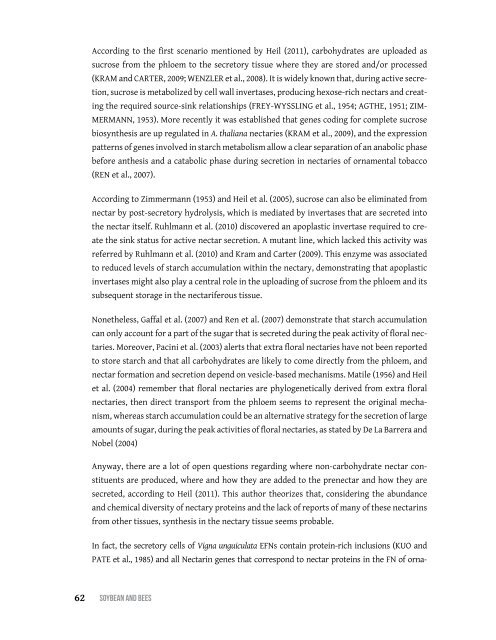Soybean and Bees
You also want an ePaper? Increase the reach of your titles
YUMPU automatically turns print PDFs into web optimized ePapers that Google loves.
According to the first scenario mentioned by Heil (2011), carbohydrates are uploaded as<br />
sucrose from the phloem to the secretory tissue where they are stored <strong>and</strong>/or processed<br />
(Kram <strong>and</strong> Carter, 2009; Wenzler et al., 2008). It is widely known that, during active secretion,<br />
sucrose is metabolized by cell wall invertases, producing hexose-rich nectars <strong>and</strong> creating<br />
the required source-sink relationships (Frey-Wyssling et al., 1954; Agthe, 1951; Zimmermann,<br />
1953). More recently it was established that genes coding for complete sucrose<br />
biosynthesis are up regulated in A. thaliana nectaries (Kram et al., 2009), <strong>and</strong> the expression<br />
patterns of genes involved in starch metabolism allow a clear separation of an anabolic phase<br />
before anthesis <strong>and</strong> a catabolic phase during secretion in nectaries of ornamental tobacco<br />
(Ren et al., 2007).<br />
According to Zimmermann (1953) <strong>and</strong> Heil et al. (2005), sucrose can also be eliminated from<br />
nectar by post-secretory hydrolysis, which is mediated by invertases that are secreted into<br />
the nectar itself. Ruhlmann et al. (2010) discovered an apoplastic invertase required to create<br />
the sink status for active nectar secretion. A mutant line, which lacked this activity was<br />
referred by Ruhlmann et al. (2010) <strong>and</strong> Kram <strong>and</strong> Carter (2009). This enzyme was associated<br />
to reduced levels of starch accumulation within the nectary, demonstrating that apoplastic<br />
invertases might also play a central role in the uploading of sucrose from the phloem <strong>and</strong> its<br />
subsequent storage in the nectariferous tissue.<br />
Nonetheless, Gaffal et al. (2007) <strong>and</strong> Ren et al. (2007) demonstrate that starch accumulation<br />
can only account for a part of the sugar that is secreted during the peak activity of floral nectaries.<br />
Moreover, Pacini et al. (2003) alerts that extra floral nectaries have not been reported<br />
to store starch <strong>and</strong> that all carbohydrates are likely to come directly from the phloem, <strong>and</strong><br />
nectar formation <strong>and</strong> secretion depend on vesicle-based mechanisms. Matile (1956) <strong>and</strong> Heil<br />
et al. (2004) remember that floral nectaries are phylogenetically derived from extra floral<br />
nectaries, then direct transport from the phloem seems to represent the original mechanism,<br />
whereas starch accumulation could be an alternative strategy for the secretion of large<br />
amounts of sugar, during the peak activities of floral nectaries, as stated by De La Barrera <strong>and</strong><br />
Nobel (2004)<br />
Anyway, there are a lot of open questions regarding where non-carbohydrate nectar constituents<br />
are produced, where <strong>and</strong> how they are added to the prenectar <strong>and</strong> how they are<br />
secreted, according to Heil (2011). This author theorizes that, considering the abundance<br />
<strong>and</strong> chemical diversity of nectary proteins <strong>and</strong> the lack of reports of many of these nectarins<br />
from other tissues, synthesis in the nectary tissue seems probable.<br />
In fact, the secretory cells of Vigna unguiculata EFNs contain protein-rich inclusions (Kuo <strong>and</strong><br />
Pate et al., 1985) <strong>and</strong> all Nectarin genes that correspond to nectar proteins in the FN of orna-<br />
62 SoybeAn <strong>and</strong> bees


